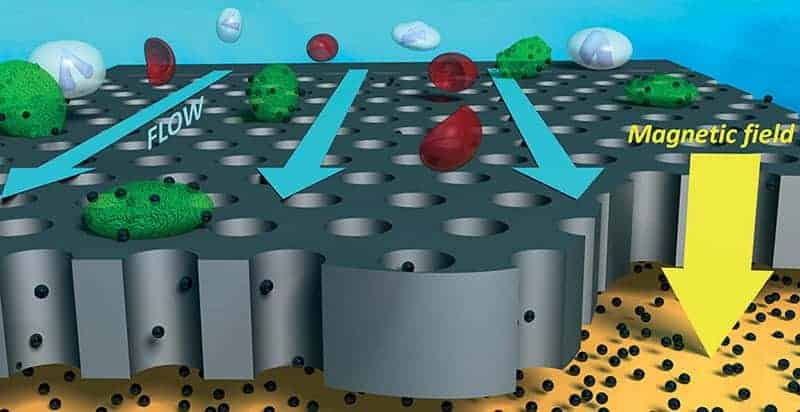Accurately diagnosing the spread of cancer often involves painful and invasive biopsy procedures. The use of a “liquid biopsy,” which involves a simple blood draw, has been shown in a five-year clinical trial to accurately detect and monitor certain kinds of breast cancer.
The study involves circulating tumor DNA (ctDNA) and circulating tumor cells (CTC), genetic and cellular material from tumors that find their way into the patient’s bloodstream. A paper on the clinical trial’s results is published in JAMA Oncology.
“These CTC cells are extremely rare,” said Cagri Savran, a professor of mechanical engineering at Purdue University. “In a blood sample of eight milliliters, there are billions of cells, but the cells we’re looking for, there may only be three or four.”
Savran and his team at the Birck Nanotechnology Center in Purdue’s Discovery Park developed a liquid biopsy device to isolate these cells. They mix blood samples with magnetic particles, functionalized with antibodies to recognize the cells they are targeting. Then they run the samples through a microfluidic device, which has a magnetic field that attracts and captures only the magnetized CTC cells.
“Once we’ve got them, we can do a number of things,” Savran said. “We can culture them, we can run tests on them and, most importantly for this trial, we can count them. The number of cells in a sample has a significant meaning.”
The device drew the attention of Milan Radovich, an associate professor at the IU Simon Comprehensive Cancer Center in Indianapolis and a 2004 Purdue graduate in biochemistry.
“I focus primarily on the use of genomics for precision medicine in oncology,” Radovich said. “We really focus on figuring out what makes cancers tick, by looking at their DNA blueprint.”
Radovich wanted to test the effectiveness of CTC detection as part of a larger clinical trial of 196 patients with triple-negative breast cancer.
“This is a particularly aggressive form of breast cancer,” he said, “and recurrence of the disease tends to be high. So after their chemotherapy, we took blood samples from the patients to see if presence of the cells was an accurate marker of disease relapse.”
Because IU Simon Comprehensive Cancer Center doesn’t have CTC technology, Radovich reached out to Purdue to test the samples. “Our novel microfluidic platform makes CTC detection simple, rapid and scalable,” Savran said. “It takes longer to ship the samples than to complete the tests.”
From 2014 to 2018, Radovich sent hundreds of blood samples to Savran, who isolated the CTC cells and reported their numbers back to Radovich.
“Because this was a blinded study, neither of us could know the results until the trial was completed,” Radovich said. “It was a long five years to wait.”
In the final analysis, their theory was proven right.
“These circulating markers were more predictive of relapse than any other commonly used clinical marker on the planet,” Radovich said. “It’s more predictive than tumor size, grade, stage or lymph node status.”
“This is the largest clinical study ever published on the use of circulating markers and minimal residual disease,” Radovich said. “This really puts it on the map.”
A video describing this work is available on YouTube.
Both Radovich and Savran are now pursuing the future of non-invasive liquid biopsies. Savran patented the idea for his device through the Purdue Research Foundation Office of Technology Commercialization and created a company, Savran Technologies Inc., to make it commercially available.
“It’s very important to me and my team of engineers that the things we build are really useful,” Savran said. “This technology is being used on real patients and now has the power to make a real difference.”
Radovich plans to continue to use the technology in future clinical trials.
“Imagine you’re a patient with this triple-negative breast cancer,” Radovich said. “Even if chemotherapy and surgery were successful, life can be a nightmare. They’ve told us that every headache or back pain incites fear that their cancer is coming back. With this technology, we can offer a more definitive answer for both physicians and patients.”
Financial support for this study was provided by the Vera Bradley Foundation for Breast Cancer Research, Walther Cancer Foundation, Indiana University Grand Challenge Precision Health Initiative and Thomas Hurvis and McKinley Educational Foundation.
About Discovery Park
Discovery Park is a place where Purdue researchers move beyond traditional boundaries, collaborating across disciplines and with policymakers and business leaders to create solutions for a better world. Grand challenges of global health, global conflict and security, and those that lie at the nexus of sustainable energy, world food supply, water and the environment are the focus of researchers in Discovery Park. The translation of discovery to impact is integrated into the fabric of Discovery Park through entrepreneurship programs and partnerships.
About Purdue University
Purdue University is a top public research institution developing practical solutions to today’s toughest challenges. Ranked the No. 6 Most Innovative University in the United States by U.S. News & World Report, Purdue delivers world-changing research and out-of-this-world discovery. Committed to hands-on and online, real-world learning, Purdue offers a transformative education to all. Committed to affordability and accessibility, Purdue has frozen tuition and most fees at 2012-13 levels, enabling more students than ever to graduate debt-free. See how Purdue never stops in the persistent pursuit of the next giant leap at https://purdue.edu/.
Media contact: Kayla Wiles, [email protected] (working remotely, but will provide immediate response)
Writer: Jared Pike
Source: Cagri Savran, [email protected]


